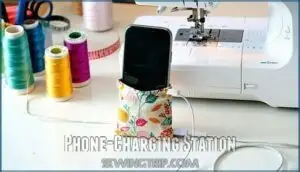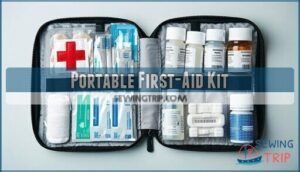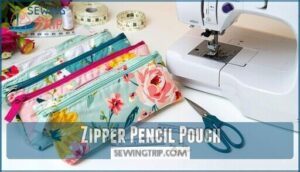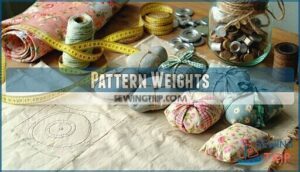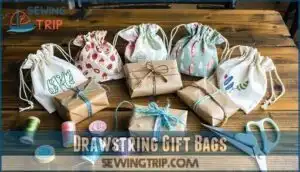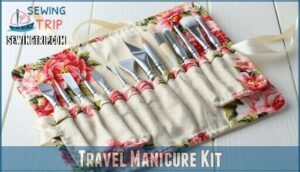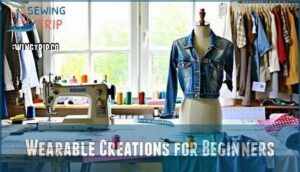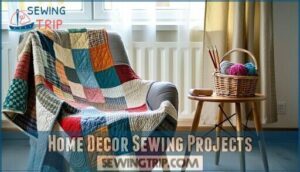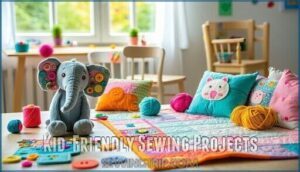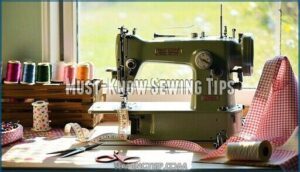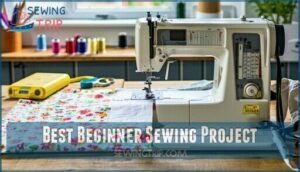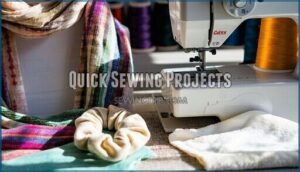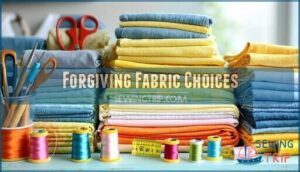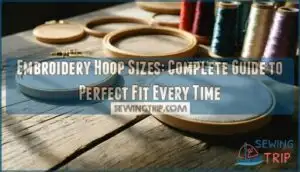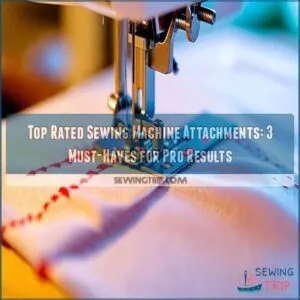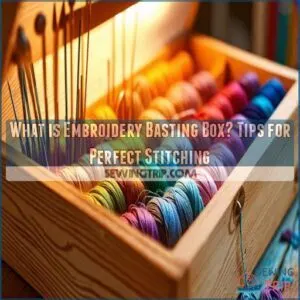This site is supported by our readers. We may earn a commission, at no cost to you, if you purchase through links.
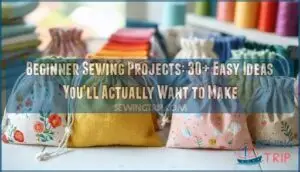 You’ll love how beginner sewing projects turn simple fabric pieces into practical treasures while building confidence with each stitch.
You’ll love how beginner sewing projects turn simple fabric pieces into practical treasures while building confidence with each stitch.
Start with forgiving fabrics like cotton and straightforward projects such as drawstring bags, fabric napkins, or zippered pouches. These don’t require perfect seams or complex techniques, making them ideal for learning basic skills like straight stitching and simple hems.
As you master these fundamentals, you’ll discover that even simple projects can solve everyday problems and create meaningful gifts. The key is choosing projects that match your current skill level while still being useful enough that you’ll actually reach for them.
There’s something magical about transforming a flat piece of fabric into something three-dimensional and functional, which can help build confidence with each stitch, and make you appreciate the value of simple projects and practical treasures.
Table Of Contents
- Key Takeaways
- Six Categories of Beginner Projects
- Useful Sewing Projects
- Sewing Gift Ideas
- Wearable Creations for Beginners
- Home Decor Sewing Projects
- Kid-Friendly Sewing Projects
- Must-Know Sewing Tips
- Best Beginner Sewing Project
- Quick Sewing Projects
- Forgiving Fabric Choices
- Frequently Asked Questions (FAQs)
- Conclusion
Key Takeaways
- You’ll build confidence by starting with forgiving fabrics like cotton and simple projects such as pillowcase covers, drawstring bags, and fabric napkins that teach straight seams without requiring perfect technique.
- You can create practical items you’ll actually use daily, including phone charging stations, zipper pouches, and first-aid kits that solve everyday problems while practicing essential sewing skills.
- You’ll discover that beginner projects make meaningful gifts, from fabric koozies and travel manicure kits to burp cloths and soft toys that show you care while building your abilities.
- You can transform your living space with simple home decor projects like table runners, outdoor pillows, and fringed accents that deliver impressive results using only basic straight seams and hemming techniques.
Six Categories of Beginner Projects
Starting your beginner sewing journey doesn’t have to feel overwhelming when you break projects into six manageable categories. Each category targets different aspects of skill building while keeping project complexity low and time commitment reasonable.
Useful projects like phone charging stations and zipper pouches teach straight seams while creating items you’ll actually use daily. Gift ideas including drawstring bags and fabric koozies let you practice basic techniques while making thoughtful presents.
Wearable creations such as simple aprons and headbands introduce you to garment construction without intimidating patterns. Home decor projects like table runners and pillow covers help you understand fabric selection and finishing techniques.
Kid-friendly items including soft toys and burp cloths offer forgiving practice with curves and small details. Finally, accessories such as scarves and belts provide quick wins that boost confidence.
This systematic approach to easy sewing helps you build skills progressively. Project customization becomes natural as you gain experience, transforming basic beginner sewing projects into personalized creations that reflect your style and needs.
Useful Sewing Projects
You’ll love these practical sewing projects that solve everyday problems while building your skills.
Each project creates something you’ll actually use, making your time at the sewing machine feel productive and rewarding.
Phone-Charging Station
Your phone deserves better than lying on the floor while charging. This DIY fabric charging station elevates your device safely while managing cord clutter through smart pocket placement.
Choose sturdy cotton or canvas for durability—the fabric choice affects both function and style. Station design takes just 30 minutes, perfect for beginner sewing enthusiasts.
The built-in pocket keeps charging cables organized and prevents tangling. Customization ideas include adding tablet-sized compartments or decorative topstitching.
This easy sewing project combines practicality with personalization, making it ideal for sewing for beginners seeking useful results. You can find instructions for a portable charging station that’s perfect for travel.
Portable First-Aid Kit
A portable first-aid kit transforms scattered medical supplies into organized peace of mind. You’ll create a compact lifesaver that fits anywhere—from your glove compartment to hiking backpack.
Kit Essentials include bandages, antiseptic wipes, pain relievers, and tweezers. Fabric Choices matter: select durable cotton or canvas that won’t tear when stuffed. Water-resistant materials work best for outdoor adventures.
Size Variations accommodate different needs—small pouches for purses or larger versions for family camping trips. Closure Options include zippers for secure storage or snap closures for quick access during emergencies.
Customization Ideas make your kit unique. Add a red cross appliqué for instant identification, or create labeled compartments using clear vinyl pockets. Multiple interior dividers prevent supplies from becoming a jumbled mess.
This beginner sewing project combines straight seams with basic construction techniques. You can even learn how to create your own with this portable version. Easy sewing meets practical purpose—you’re not just practicing stitches, you’re preparing for life’s unexpected moments. Sewing for beginners doesn’t get more rewarding than creating something genuinely useful.
Zipper Pencil Pouch
A simple zipper pencil pouch transforms from basic storage into your personal style statement. This project teaches essential zipper types and fabric selection while you create something genuinely useful for school or work.
Here’s what makes this project special:
- Freedom to experiment – Try different lining options and custom embellishments without fear
- Instant gratification – Complete your first zipper pencil pouch in under an hour
- Endless possibilities – Master size variations to create pouches for makeup, cables, or art supplies
Perfect for sewing for beginners, this easy sewing project builds confidence through straightforward construction. You’ll practice straight seams while creating beginner sewing projects that friends actually want. Each pouch becomes a canvas for your creativity and a stepping stone toward more complex sewing projects for beginners.
Consider the available pouch options when selecting your materials.
Pattern Weights
When you’re cutting fabric, pattern weights become your best friends for keeping everything perfectly in place.
These handy sewing tools and supplies replace pins and prevent fabric shifting during the cutting process.
Making DIY pattern weights is one of the most practical beginner sewing projects you’ll tackle.
| Weight Materials | DIY Options |
|---|---|
| Metal washers | Fabric-wrapped rocks |
| Decorative stones | Rice-filled pouches |
| Small sandbags | Button collections |
| Magnetic discs | Weighted fabric squares |
| Glass gems | Repurposed hardware |
Weight distribution matters more than you’d think.
Heavier weights work best for thick fabric types like denim, while lighter options suit delicate materials.
Storage solutions can be as simple as a mason jar or decorative box.
You’ll find these pattern weights invaluable for your sewing for beginners guide, making precise cuts effortless and improving your overall sewing experience.
Sewing Gift Ideas
Nothing beats the satisfaction of giving a handmade gift that shows you truly care about someone.
These beginner-friendly projects let you create thoughtful presents without needing advanced sewing skills or expensive materials.
Drawstring Gift Bags
Creating drawstring gift bags transforms any fabric scrap into a thoughtful present holder that’s both practical and personal. These beginner sewing projects prove that the simplest ideas often make the biggest impact.
Fabric selection opens endless possibilities—from festive holiday prints to elegant solids that match any occasion. Size variations let you customize bags for everything from jewelry to books, while closure methods range from simple ribbon drawstrings to decorative braided cords. The beauty lies in how easily you can match each bag to its contents and recipient.
Your decoration ideas can include:
- Hand-embroidered initials that make each bag a keepsake worth saving
- Fabric paint designs that turn plain cotton into personalized art
- Appliqué shapes that add texture and whimsy to any celebration
- Contrasting trim that elevates simple bags into elegant gift wrap alternatives.
Perfect for birthdays, holidays, or any gifting occasions, these easy sewing projects teach essential skills while creating something genuinely useful. Each bag becomes wrapping paper that recipients actually want to keep.
Fabric Koozies
Fabric koozies make perfect gifts that keep drinks cold while showing off your personal style.
You’ll love how these beginner-friendly fabric projects come together quickly with just straight seams and basic materials.
| Koozie Insulation Types | Koozie Fabric Options | Koozie Sewing Techniques |
|---|---|---|
| Foam padding | Cotton canvas | Straight seams |
| Fleece lining | Neoprene | French seams |
| Batting layers | Denim scraps | Zigzag edges |
These customizable koozies let you experiment with different fabric combinations and koozie gift ideas.
Whether you’re making a set for the office party or creating thoughtful presents for friends, these easy sewing projects deliver practical results that everyone will actually use.
Travel Manicure Kit
Organizing your nail care essentials becomes effortless with this roll-up travel manicure kit that fits perfectly in any purse or suitcase.
You’ll love how this compact design keeps your tools secure and easily accessible wherever you go. A practical option includes a complete manicure set for on-the-go nail care.
Here’s what makes this beginner sewing project perfect:
- Compact Design – Rolls up tightly for maximum portability
- Tool Organization – Individual pockets prevent items from shifting
- Travel Safety – Secure ribbon closure keeps everything contained
- Closure Options – Choose between ribbon ties or snap alternatives
This easy sewing gift prevents tool loss while showcasing your fabric choices beautifully.
Scalloped Sunglasses Case
While your manicure kit keeps your nails perfectly polished, your sunglasses deserve equal protection.
You’ll master scallop techniques while creating this stylish case that transforms fabric scraps into personalized gifts.
Choose your closure options—velcro, snap, or button—then add case lining for extra cushioning.
| Design Element | Beginner Option | Advanced Touch |
|---|---|---|
| Edge Style | Simple scallops | Layered scalloping |
| Closure | Velcro strip | Decorative button |
| Lining | Cotton batting | Quilted interior |
| Embellishment | Fabric paint | Hand embroidery |
| Personalization | Monogram patch | Custom appliqué |
This easy sewing project teaches valuable skills while creating something you’ll actually use daily.
Wearable Creations for Beginners
You’ll love creating your first wearable pieces because they’re surprisingly simple and give you something stylish to show off.
These beginner-friendly garments teach you essential skills like hemming and basic construction while you make items you’ll actually wear, which helps you learn basic construction.
Pillowcase Dresses and Tops
Pillowcase dresses and tops offer the perfect entry point into garment making.
You’ll complete these beginner sewing projects in under 2.5 hours using basic straight seams and minimal materials.
These versatile pieces grow with children, functioning as dresses for toddlers and tops for older kids.
Start with these essential steps for success:
- Fabric selection – Choose cotton or lightweight fabrics that drape well
- Sizing variations – Measure chest circumference and desired length for proper fit
- Custom embellishments – Add bias tape, ribbons, or lace for personal flair
- Easy alterations – Adjust armholes with double-fold bias tape for comfort
- Styling options – Layer over shirts or wear alone for seasonal versatility
These sewing patterns for beginners teach fundamental skills while creating functional wardrobe pieces.
The adjustable ribbon neckline accommodates different sizes, making them ideal for gifts or charitable sewing projects.
Easy sewing doesn’t get much simpler than this forgiving design.
Easy Clutch
Within minutes, you’ll have a stylish accessory that’ll turn heads wherever you go.
An easy clutch makes the perfect beginner sewing project because it requires only straight seams and basic techniques.
| Clutch Fabrics | Closure Options | Strap Styles |
|---|---|---|
| Cotton canvas | Magnetic snap | Detachable chain |
| Faux leather | Zipper closure | Fabric loop |
| Quilting cotton | Button tab | Wrist strap |
| Denim scraps | Velcro strip | No strap design |
| Upholstery fabric | Fold-over flap | Adjustable cord |
Start with forgiving fabrics like cotton or canvas—they’re easier to handle than slippery materials.
Master your cutting techniques first, then focus on straight stitching.
Lining techniques aren’t necessary for beginners, but they’ll give your clutch a professional finish.
Add embellishment ideas like decorative stitching or fabric paint after you’ve completed the basic structure.
This beginner sewing project builds confidence while creating something you’ll actually use.
Your easy sewing skills will shine through this practical yet fashionable accessory.
30. Minute Apron
Transform your kitchen routine with a simple 30-minute apron that combines practicality with personal style.
This beginner sewing project teaches essential techniques while creating something you’ll actually use daily.
Master these key elements for apron success:
- Apron Fabric Choice – Cotton or linen blends offer durability and easy washing
- Customizing Apron Pockets – Add multiple sizes for tools, phones, and treats
- Apron Style Variations – Choose half, full, or crossback designs for comfort
- Easy Apron Embellishments – Try fabric paint, embroidery, or fun trim
- Apron Gift Ideas – Personalize with names or hobby themes for loved ones
This simple sewing project builds confidence through straight seams and basic construction.
Perfect for beginner sewing tutorials, it’s forgiving enough for mistakes yet stylish enough to wear proudly.
Fabric Headbands
Accessories like fabric headbands offer endless possibilities for personal expression. You’ll create stylish pieces that complement any outfit while mastering basic sewing skills.
These beginner sewing projects require minimal fabric and time, making them perfect for quick crafting sessions. Start with comfortable cotton or jersey knits for all-day wear. Consider your head circumference when cutting fabric—most adults need 18-20 inches of material. Add seam allowances for a proper fit.
| Fabric Choices | Embellishment Ideas | Closure Types |
|---|---|---|
| Cotton jersey | Fabric flowers | Elastic band |
| Knit fabrics | Decorative buttons | Velcro strips |
| Fleece material | Bow attachments | Tie closures |
Follow sewing tutorials for headband sizing tips—too tight causes discomfort, too loose won’t stay put. Easy sewing patterns often include multiple width options. You can find free sewing tutorials online to guide you.
For styling tips, coordinate headband colors with your wardrobe or create seasonal collections using different textures and patterns.
Home Decor Sewing Projects
Transform your living space with simple sewing projects that add personality without breaking the bank.
These home decor pieces require basic skills but deliver impressive results that’ll make your guests think you’re a decorating pro.
Quick Table Runner
Transform your dining space with a quick table runner that’ll make your table sing! This beginner-friendly project teaches fundamental sewing skills while creating something genuinely useful for your home.
Here’s what makes table runners perfect starter projects:
- Fabric Selection – Cotton, linen, or canvas work beautifully and forgive beginner mistakes
- Pattern Variations – Try geometric prints, florals, or solid colors to match your style
- Edging Techniques – Practice hemming, binding, or decorative stitching on the borders
- Reversible Runners – Sew two coordinating fabrics together for double the decorating power
- Seasonal Fabrics – Switch between autumn leaves, winter snowflakes, or spring botanicals
You’ll need basic measurements (your table length plus 12-24 inches for overhang), straight seams, and simple finishing techniques.
This quick sewing project builds confidence while creating something you’ll actually use every day.
Fabric Napkins
Fabric napkins represent one of the most rewarding beginner sewing projects you’ll tackle.
These reusable dining essentials let you practice essential hemming techniques while creating something genuinely useful.
Start with simple cotton fabric choices—they’re forgiving and easy to work with.
Cut squares in various size variations to accommodate different dining etiquette needs.
Consider reversible designs by choosing coordinating fabrics for added versatility.
You’ll master straight seams and corner finishing while reducing waste.
Perfect for sewing for beginners, this simple sewing project builds confidence through practical application, making it an ideal way to practice essential techniques.
Fringed Table Runner
Add textural interest to your dining space with a fringed table runner that brings rustic charm without breaking the bank.
This beginner-friendly project teaches essential sewing techniques while creating stunning table decor that’ll impress your guests.
Here’s what makes this project perfect for beginners:
- Fabric choices – Cotton, linen, or burlap work beautifully
- Runner length – Measure your table plus 12-24 inches overhang
- Fringed edges – Simply pull threads or cut strips for instant texture
- Sewing techniques – Straight seams and basic hemming only
- Customization – Mix patterns or add decorative stitching
You’ll master fundamental skills while creating a versatile piece that works for casual dinners or special occasions.
Outdoor Pillow
Bringing comfort outdoors starts with choosing the right pillow fabric. Weather-resistant materials like canvas or outdoor-specific textiles will keep your creations looking fresh season after season.
These simple sewing projects transform any patio into a cozy retreat. When selecting materials, consider the importance of durable outdoor pillow cover designs to guarantee long-lasting results.
| Fabric Choice | Best For |
|---|---|
| Canvas | Durability and easy cleaning |
| Outdoor polyester | UV resistance and quick drying |
| Marine vinyl | Waterproof protection |
When creating outdoor pillow covers, you’ll need basic sewing tips like using sharp needles and outdoor thread. These DIY sewing projects are perfect for beginners who want practical results.
Skip pins on coated fabrics—they’ll leave permanent holes. Instead, use clips or weights while cutting.
Fur-Trimmed Pillow Cover
The luxurious faux fur trim instantly elevates any ordinary pillow into a statement piece that screams sophistication.
This beginner-friendly DIY sewing project transforms your living space without breaking the bank.
- Fabric Choice: Select coordinating cotton or linen for the base with contrasting faux fur trim
- Sewing Tips: Use a walking foot to handle thick fur materials smoothly
- Home Accent: Position strategically on sofas or chairs for maximum visual impact
- Pillow Decor: Mix textures by pairing with smooth velvet or woven pillowcases nearby
Kid-Friendly Sewing Projects
Kid-friendly projects make perfect gifts and help little ones feel special with handmade items just for them.
You’ll find these simple projects use basic techniques while creating adorable results that babies and children will love for years to come, making them truly special.
Sea Turtle Softie
Create this charming sea turtle softie using bright, ocean-inspired fabrics that’ll make kids smile.
Choose soft cotton or fleece for easy handling—perfect for beginner sewing projects.
Cut your turtle pattern pieces, then sew them together with a quarter-inch seam allowance.
Leave a small opening for stuffing your cuddly friend with polyester fiberfill.
Hand-stitch safety eyes or embroider features for younger children.
These turtle toys make wonderful baby sewing gifts and teach basic softie patterns while you’re crafting stuffed animals that’ll become treasured companions.
Burp Cloths
You’ll find burp cloths are among the most rewarding baby essentials to sew.
These practical pieces require minimal fabric and basic straight seams, making them perfect for beginners.
Here’s what makes burp cloth patterns so appealing:
- Fabric choices – Cotton flannel, terry cloth, or absorbent bamboo work best
- Sewing tips – Use French seams for extra durability and professional finishing
- Baby sewing versatility – Perfect companion project when making baby bibs or planning your diaper and wipes holder
Diaper and Wipes Holder
Seventy-two hours after bringing baby home, you’ll realize organization saves your sanity.
This diaper and wipes holder keeps baby essentials within arm’s reach during those middle-of-the-night changes.
Perfect for sewing beginners, this DIY sewing project transforms fabric scraps into practical nursery organizers, teaching basic skills while creating functional baby accessories.
Your homemade wipes cases beat store-bought diaper bags hands down—they’re customizable, washable, and incredibly useful for baby sewing enthusiasts, making them a great example of how DIY projects can be practical.
Kids’ Pillow Bed
Why settle for uncomfortable floor seating when you can craft a cozy kids pillow bed?
This portable design transforms any room into a comfortable reading nook or sleepover spot.
Using a twin flat sheet and four standard pillows, you’ll create pockets that keep everything secure.
Simply fold your sheet, sew straight lines to form compartments, then slide pillows inside.
Kids love these portable beds for movie nights, and parents appreciate the easy storage.
Perfect for beginners seeking practical sewing projects for children.
Simple Baby Blanket
A soft baby blanket becomes a treasured keepsake when you sew it yourself.
Choose gentle baby fabric like flannel or minky in soothing pastels.
These simple sewing projects for beginners require just straight seams and basic blanket patterns.
Add the baby’s name with simple embroidery for personalized baby gifts.
Finish edges with a rolled hem or decorative binding for beautiful nursery decor.
Must-Know Sewing Tips
Master these sewing basics to transform your beginner projects from frustrating to fabulous.
Smart fabric selection and proper sewing techniques will save you countless hours of rework and boost your confidence at the machine.
- Choose stable woven fabrics like cotton over stretchy knits for your first easy sewing projects
- Practice straight stitches on scrap fabric before tackling your actual sewing for beginners piece
- Thread your machine properly with the presser foot raised to engage tension discs correctly
- Press seams open after stitching to create professional-looking finishes
These sewing tips aren’t just rules—they’re your ticket to freedom from tangled thread and crooked seams.
Understanding sewing machine basics is essential for successful projects.
Best Beginner Sewing Project
The pillowcase stands as the ultimate beginner sewing project, offering new sewers a perfect foundation in sewing basics.
This simple rectangle requires only straight seams, making it ideal for practicing fabric selection and getting comfortable with your sewing machine.
You’ll master essential sewing tools while creating something genuinely useful for your home.
The forgiving nature of this project means small mistakes won’t ruin the final result, building your confidence for future sewing projects for beginners.
Plus, you can customize it with any fabric that matches your style preferences.
Quick Sewing Projects
Sometimes the best sewing adventures happen when you’re racing against the clock. Quick sewing projects let you create something beautiful in just 30 minutes to two hours, perfect for weekend afternoons or stolen moments between daily chaos.
Start with simple accessories that pack maximum impact. Scrunchies require only fabric scraps and elastic—you’ll master basic seams while creating colorful hair ties. Fabric headbands need just two straight stitches, making them ideal for practicing your sewing tools technique.
These fast fabrics projects build confidence without overwhelming your schedule. Try DIY patterns for infinity scarves using knit materials that forgive wobbly stitches. The forgiving nature of these beginner sewing projects means imperfections become character, not mistakes.
Quick stitches on fleece create cozy accessories without requiring advanced skills. These easy sewing projects prove that simple sewing doesn’t sacrifice style. Each completed piece becomes a small victory, fueling your enthusiasm for more ambitious creations ahead. Exploring various fast sewing techniques can help you discover new favorite projects to enjoy in your free time.
Forgiving Fabric Choices
The right fabric can make or break your first sewing adventure. Cotton fabrics top the list because they’re stable, affordable, and won’t shift around while you’re stitching. Quilting cotton gives you thousands of print options while staying budget-friendly and forgiving.
Cotton fabrics won’t fight you while you learn – they’re your sewing best friend.
Knit materials like jersey offer gentle stretch that hides sizing mistakes. Fabric blends with polyester boost durability and need less ironing. When making textile selection choices, stick with medium-weight options that won’t jam your machine or fray excessively.
One way to save money is by checking local fabric stores for remnant bins.
Smart sewing textures for beginners include:
- Muslin – Cheap practice fabric that handles multiple seam-ripping sessions
- Chambray – Denim look without the bulk or difficulty
- Flannel – Brushed surface conceals minor stitching wobbles
- Cotton voile – Lightweight but structured enough for garments
Save slippery satins and stretchy knits for later projects. These beginner sewing projects work best with stable, cooperative fabrics that won’t fight you. Focus on mastering basic techniques first – the fancy materials can wait until you’ve built confidence with simple sewing and easy sewing projects for beginners.
Frequently Asked Questions (FAQs)
What is the easiest thing to sew for a beginner?
Getting your feet wet in the sewing world doesn’t have to be intimidating.
You’ll find pillow covers are your best friend – they’re forgiving, require only straight seams, and you’ll actually use them.
What is the easiest material to sew for beginners?
Cotton fabric is your best friend when you’re starting out.
It’s forgiving, doesn’t slip around, and holds its shape well.
You’ll find it easy to handle and perfect for practicing those first straight seams.
What is the first thing you should learn to sew?
Nearly 70% of new sewers quit after their first failed project, but you’ll succeed by starting with a simple pillowcase. It teaches straight seams and basic construction without overwhelming complexity.
How to start sewing with no experience?
Start with basic supplies: sewing machine, thread, fabric scissors, and pins. Choose simple projects like pillowcases or tote bags. Practice straight seams first, then gradually tackle zippers and curves.
What sewing machine should I buy first?
Like choosing your first paintbrush for a masterpiece, you’ll want a basic mechanical sewing machine.
Look for Brother, Singer, or Janome models under $200 with automatic threading and multiple stitches.
Skip computerized features.
How much fabric do I need?
Fabric amounts depend on your project size and pattern requirements. Most beginner projects need 1/4 to 1 yard. Check your pattern for specific yardage, then buy extra for mistakes.
What thread types work for beginners?
Thread is your sewing project’s backbone—choose wisely!
You’ll want all-purpose polyester thread for most fabrics since it’s strong, affordable, and forgiving.
Cotton thread works beautifully with natural fabrics, while serger thread offers stretch for knits.
Which scissors are best for cutting?
You’ll want sharp fabric scissors that cut cleanly through material.
Invest in quality shears like Gingher or Fiskars – they’ll slice through fabric effortlessly and stay sharp longer than cheap alternatives.
How do I fix common mistakes?
Back in the day, mistakes were learning opportunities.
Keep your seam ripper handy—it’s your best friend for undoing crooked lines or wrong turns.
Practice on scraps first, take your time, and remember that even experienced sewers make mistakes regularly.
Conclusion
Every thread you sew weaves together skill and creativity, transforming your beginner sewing projects into stepping stones toward mastery.
You’ve discovered that simple stitches can create practical treasures, meaningful gifts, and confidence-building victories.
Whether you’re crafting useful organizers, wearable accessories, or home decor pieces, each project teaches valuable techniques while producing something you’ll actually use.
Remember to choose forgiving fabrics, start with straightforward patterns, and celebrate every finished piece, as your sewing journey begins with that first stitch.
- https://rebecca-angela.com.au/learn-to-sew-sewing-straight-and-easy-beginner-projects/
- https://www.positivelysplendid.com/easy-sewing-projects-for-beginners/
- https://arrowsewing.com/blog/25-essential-sewing-books-for-beginners/
- https://www.polkadotchair.com/50-fun-beginner-sewing-projects/
- https://www.hobbycraft.co.uk/ideas/sewing-projects-for-beginners.html

